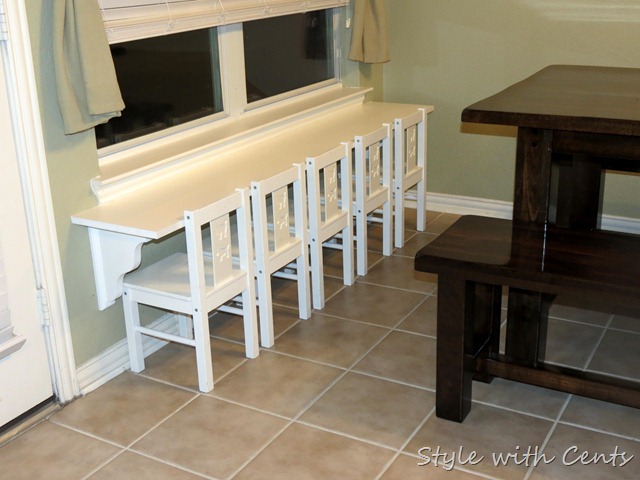Hi Guys, I am starting the New Year off right, my computer crashed. I am having Windows 7 put on my computer, it's going to take a few days. I have a hard copy of all of my clients' e-mails. If you want to send a new e-mail to the camceiling@ frontiernet.net address to make sure I have it, you may.
Will update you all soon. TTYL Kris
Saturday, December 31, 2011
Friday, December 30, 2011
How to: Disassemble your shower trim
Okay. Someone asked for a tutorial. Here is the best I can do.
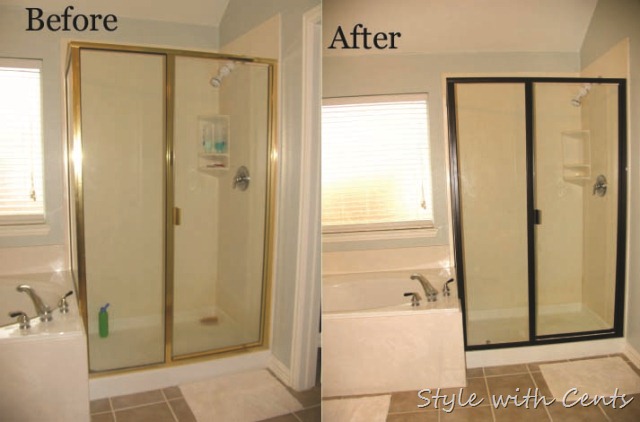
Begin disassembling your shower by pulling out all of the rubber braces from both the inside and outside of the shower. If your shower does not have these, I guess you just omit this … and maybe find another tutorial because I can’t tutor you on a subject I don’t understand myself. ;)
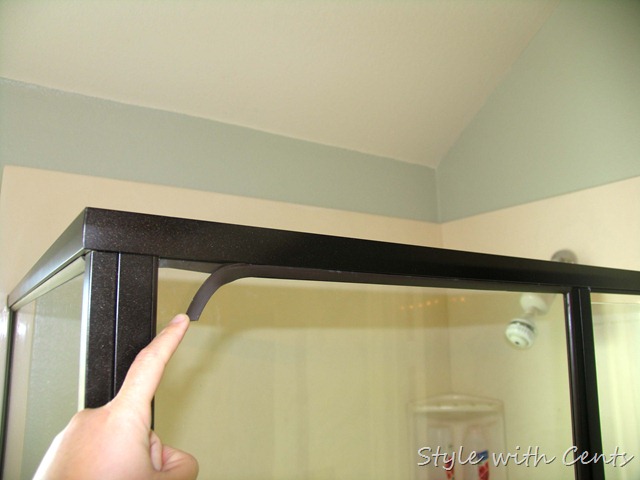
Once you have removed all the rubber braces things, you’ll want to carefully begin unscrewing the different pieces from one another. WARNING: This is a two person job, minimum. No exceptions. You cannot do this yourself. Even if you are Superman.
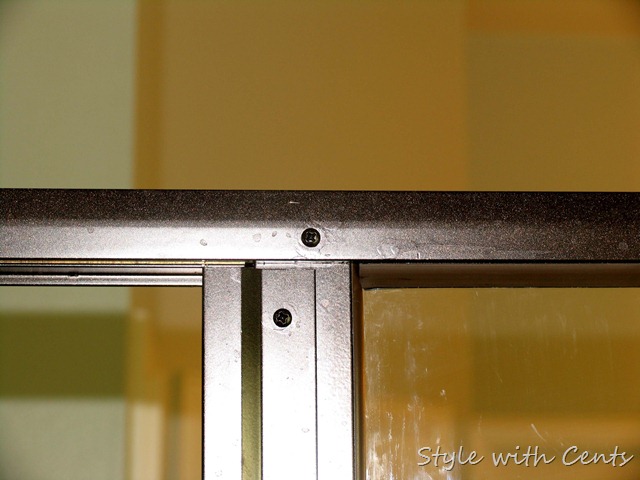
We started at the back corner of the shower, opposite the door, pulled the top section off, and then kind of followed an obvious order on what to take apart next. PLEASE make a note of where each piece goes and how it fits back together.
There are so many pieces … and it’s difficult to put the puzzle back together once you are done. Difficult. Not impossible, just difficult.
Once you have all of the pieces taken apart and your shower is totally disassembled, you’ll need to start soaking. Soaking? Yes. Soaking. Our solvent of choice was Xylene (you can find it at Home Depot). That stuff eats through plastic cups in 3 minutes flat. This is good news … cause you’ll have an awful lot of silicone caulking that will need to be soaked and eaten up by the Xylene. Soak all the parts with silicone in the Xylene for about an hour. Then, it will be loose enough to scrap right off with a razor blade.
After you have successfully removed every shred of silicone (and I mean every shred – paint will not stick to silicone … NOTHING sticks to silicone), you can begin sanding. Use a very fine grit sand paper and lightly sand all of the surfaces of the trim.
Clean and dry all trim pieces … and then … rig up a ridiculous apparatus in the garage so that you can begin spraying all the pieces. Your ghetto rig job should look something like this:
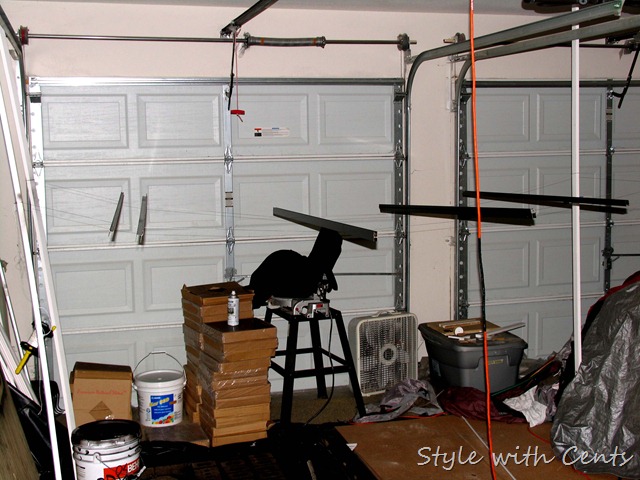
(Don’t judge me based on my garage right now. We are in the middle of re-doing our entire house … by ourselves. This is our workshop for now.)
Superman took fishing line (you can use very thin string as well) and tied several pieces back and forth across 4 boards in the garage. Then, he laid the pieces of trim on top of those and sprayed the top and bottom and sides all at the same time. (You’ll want to string your lines high enough that you can get under them to spray them at the same time.)
When he was finished, there was just tiny little spots that needed to be touched up with a small brush, which I did after the shower was put back together. (I just sprayed some of the spray paint into the lid of the can and used a small water color brush to touch up the imperfections) You’ll need to do a few touch ups after you get the shower put back together, so don’t panic if you chip any paint in the process. Once you touch it up, it holds up REALLY well. We’re a month in (and about 50 showers in) and there is no visible wear. :D
When you put the shower back together, you need to make sure that you put silicone caulking under each piece that touches the surface of the shower, whether it is on the floor or wall. Then, use silicone caulk to caulk all of the edges of the trim around the entire shower.
Like I said, it’s intense. But, totally worth it! :D
And, you can enjoy your very own before and after pictures!!


Begin disassembling your shower by pulling out all of the rubber braces from both the inside and outside of the shower. If your shower does not have these, I guess you just omit this … and maybe find another tutorial because I can’t tutor you on a subject I don’t understand myself. ;)

Once you have removed all the rubber braces things, you’ll want to carefully begin unscrewing the different pieces from one another. WARNING: This is a two person job, minimum. No exceptions. You cannot do this yourself. Even if you are Superman.

We started at the back corner of the shower, opposite the door, pulled the top section off, and then kind of followed an obvious order on what to take apart next. PLEASE make a note of where each piece goes and how it fits back together.
There are so many pieces … and it’s difficult to put the puzzle back together once you are done. Difficult. Not impossible, just difficult.
Once you have all of the pieces taken apart and your shower is totally disassembled, you’ll need to start soaking. Soaking? Yes. Soaking. Our solvent of choice was Xylene (you can find it at Home Depot). That stuff eats through plastic cups in 3 minutes flat. This is good news … cause you’ll have an awful lot of silicone caulking that will need to be soaked and eaten up by the Xylene. Soak all the parts with silicone in the Xylene for about an hour. Then, it will be loose enough to scrap right off with a razor blade.
After you have successfully removed every shred of silicone (and I mean every shred – paint will not stick to silicone … NOTHING sticks to silicone), you can begin sanding. Use a very fine grit sand paper and lightly sand all of the surfaces of the trim.
Clean and dry all trim pieces … and then … rig up a ridiculous apparatus in the garage so that you can begin spraying all the pieces. Your ghetto rig job should look something like this:

(Don’t judge me based on my garage right now. We are in the middle of re-doing our entire house … by ourselves. This is our workshop for now.)
Superman took fishing line (you can use very thin string as well) and tied several pieces back and forth across 4 boards in the garage. Then, he laid the pieces of trim on top of those and sprayed the top and bottom and sides all at the same time. (You’ll want to string your lines high enough that you can get under them to spray them at the same time.)
When he was finished, there was just tiny little spots that needed to be touched up with a small brush, which I did after the shower was put back together. (I just sprayed some of the spray paint into the lid of the can and used a small water color brush to touch up the imperfections) You’ll need to do a few touch ups after you get the shower put back together, so don’t panic if you chip any paint in the process. Once you touch it up, it holds up REALLY well. We’re a month in (and about 50 showers in) and there is no visible wear. :D
When you put the shower back together, you need to make sure that you put silicone caulking under each piece that touches the surface of the shower, whether it is on the floor or wall. Then, use silicone caulk to caulk all of the edges of the trim around the entire shower.
Like I said, it’s intense. But, totally worth it! :D
And, you can enjoy your very own before and after pictures!!

Table for Five
I think this is my very favorite thing in my house … it’s definitely the most used project we’ve done.
Superman built this at the end of the summer, when I presented him with a challenge: seat 5 kids in a 6 square foot space. The outcome was perfect!
The table, or ‘bar’ if you will, is a 6 foot shelf from Home Depot. I picked one that was laminate (read: WATER PROOF) for $13.
Then, I found a couple two way shelf brackets
The chairs are from IKEA
He mounted the table just under the window sill and then caulked the tiny gap between the two. It was a super easy project, took a couple hours of time, and cost about $90, including chairs. In the event that you find yourself needing to seat quintuplets in a small space, you now have the solution. ;)
Tuesday, December 20, 2011
$50 Master Bath Re-do
Finally.
After 6+ years of loving the size of our master bathroom, but not loving the look of our master bathroom, we decided to change it.
Only problem? Our budget.
$50.
I honestly had no idea how much we could accomplish, but set out to change the look of our bathroom as much as possible … using our tiny little budget. I would love to change out the light fixture and faucets … but in order to change all 3 faucets, the shower head/kit, and light fixture, it was a hefty $1,000. Um. No.
Instead, using my trusty Rust-Oleum Oil Rubbed Bronze spray paint … we stuck with the old and pushed forward with the face lift.
… we stuck with the old and pushed forward with the face lift.
Gary took down the old light fixture and spray painted it with oil rubbed bronze (it looks black, but it’s not). He taped off the entire bathroom and used the same oil rubbed bronze to spray the cabinets. They. Are. Gorgeous.
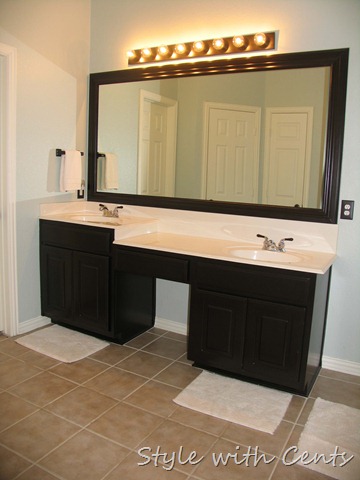
He also built the mirror frame using baseboard from Home Depot. The baseboard was around $18, give or take a few cents.

He also took down the towel rod and sprayed that to match.

By far, the trickiest part was the shower trim. Superman had to take the entire shower apart, sand down all of the silicone, spray paint everything to match, put it all back together, and silicone everything to make it once again water proof. Serious work. I will not lie to you. However, what would have cost us around $800 to replace … wound up costing us a mere $5 to paint. And, I’m happy to report that after several showers, it is holding up nicely. (Rustoleum is an indoor/outdoor paint, so we knew it could take the water)
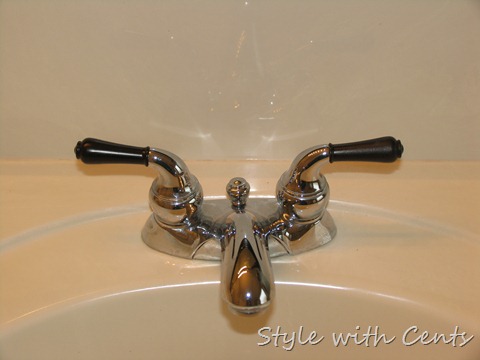
All of the handles on the faucets were brass. I hate brass! So, we unscrewed them and sprayed those too. Why not?!
Then, I dug out a couple of treasures that I bought while I was in college. Yes, 11 years ago. I’m impressed that I still had them.

Even more impressed that I once purchased something so ugly. They were $1 each … and I needed somewhere to store my paints. Fast forward 11 years, and bam:
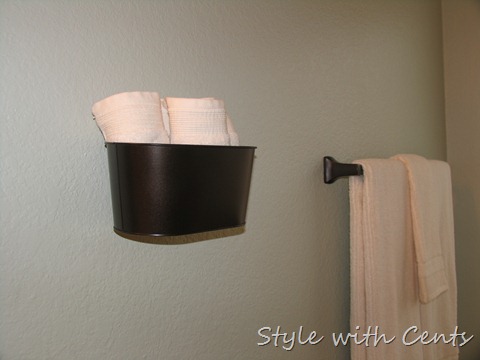
I now have a unique washcloth bin/holder … and …
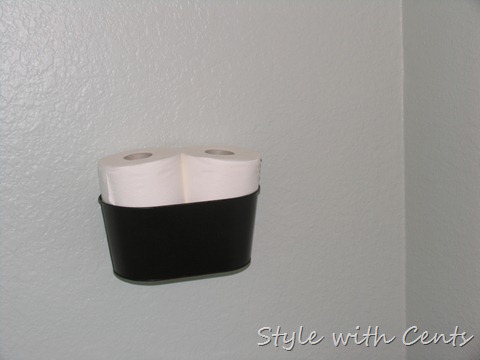
a convenient cubby to hold 2 extra rolls of toilet paper in my toilet closet …
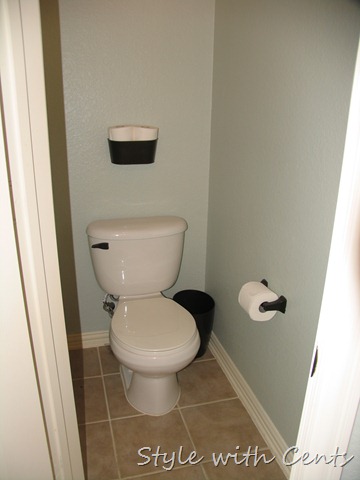
… so simple and so perfect! We didn’t care for the trash can that was in the toilet closet; however, I wasn’t about to spend another dime on a trash can … so, we spray painted it. Again, why not?! We also spray painted the toilet handle and toilet paper holder while we were at it. :D
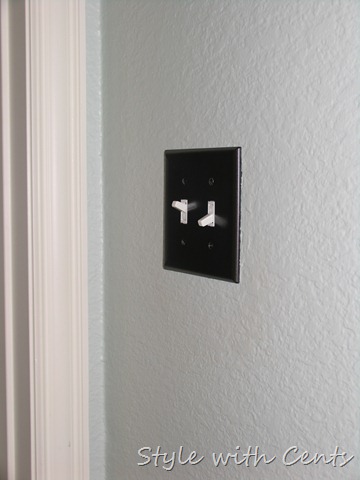
And, since we were already spray painting everything else, we decided to take off all the outlet covers and switch plates and spray those too. Because I am OCD … and I like it when absolutely everything matches.

This chic towel rod/holder used to be a brace for my Grams to help herself on and off of the toilet. It was a shiny chrome that matched exactly nothing. We spray painted it … and now it’s a towel rod … much better looking than the builder grade circular towel holder that used to be in its place.

These are not the most aesthetically pleasing light fixtures; however, if I use what I have, I spend less. This is the goal.
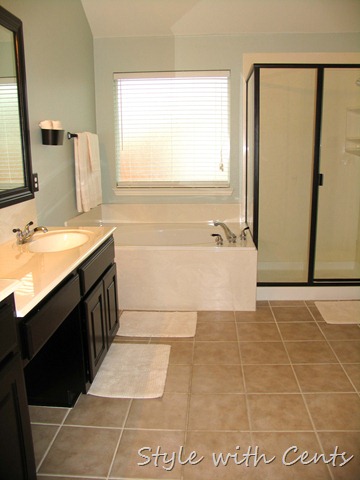
On Black Friday, I stood in line at Kohl’s for 2 1/2 hours. As a reward, I scored 4 bath mats, 2 bath towels, 2 hand towels, and 4 wash clothes for $23. Well worth the wait … at 3am. ;)
So, here is the breakdown:
$18 for baseboard
$23 for towels/bath mats
$10 for spray paint
The project took us a solid two weeks. Although we didn’t spend much money, it was very labor intensive … but oh, so worth it! Here’s a final before/after look:
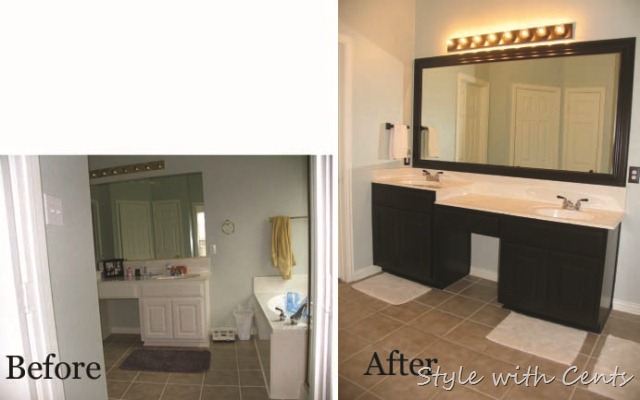
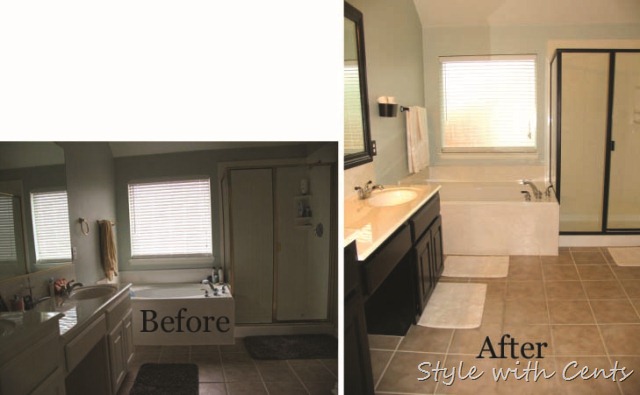
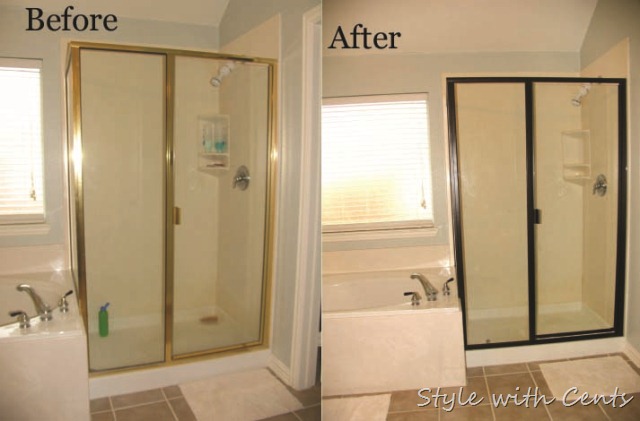
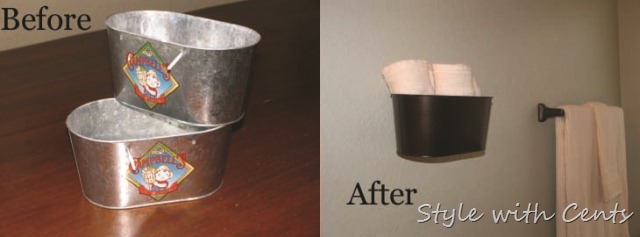
Worth every penny … and every minute! :D
After 6+ years of loving the size of our master bathroom, but not loving the look of our master bathroom, we decided to change it.
Only problem? Our budget.
$50.
I honestly had no idea how much we could accomplish, but set out to change the look of our bathroom as much as possible … using our tiny little budget. I would love to change out the light fixture and faucets … but in order to change all 3 faucets, the shower head/kit, and light fixture, it was a hefty $1,000. Um. No.
Instead, using my trusty Rust-Oleum Oil Rubbed Bronze spray paint
Gary took down the old light fixture and spray painted it with oil rubbed bronze (it looks black, but it’s not). He taped off the entire bathroom and used the same oil rubbed bronze to spray the cabinets. They. Are. Gorgeous.

He also built the mirror frame using baseboard from Home Depot. The baseboard was around $18, give or take a few cents.

He also took down the towel rod and sprayed that to match.

By far, the trickiest part was the shower trim. Superman had to take the entire shower apart, sand down all of the silicone, spray paint everything to match, put it all back together, and silicone everything to make it once again water proof. Serious work. I will not lie to you. However, what would have cost us around $800 to replace … wound up costing us a mere $5 to paint. And, I’m happy to report that after several showers, it is holding up nicely. (Rustoleum is an indoor/outdoor paint, so we knew it could take the water)

All of the handles on the faucets were brass. I hate brass! So, we unscrewed them and sprayed those too. Why not?!
Then, I dug out a couple of treasures that I bought while I was in college. Yes, 11 years ago. I’m impressed that I still had them.

Even more impressed that I once purchased something so ugly. They were $1 each … and I needed somewhere to store my paints. Fast forward 11 years, and bam:

I now have a unique washcloth bin/holder … and …

a convenient cubby to hold 2 extra rolls of toilet paper in my toilet closet …

… so simple and so perfect! We didn’t care for the trash can that was in the toilet closet; however, I wasn’t about to spend another dime on a trash can … so, we spray painted it. Again, why not?! We also spray painted the toilet handle and toilet paper holder while we were at it. :D

And, since we were already spray painting everything else, we decided to take off all the outlet covers and switch plates and spray those too. Because I am OCD … and I like it when absolutely everything matches.

This chic towel rod/holder used to be a brace for my Grams to help herself on and off of the toilet. It was a shiny chrome that matched exactly nothing. We spray painted it … and now it’s a towel rod … much better looking than the builder grade circular towel holder that used to be in its place.

These are not the most aesthetically pleasing light fixtures; however, if I use what I have, I spend less. This is the goal.

On Black Friday, I stood in line at Kohl’s for 2 1/2 hours. As a reward, I scored 4 bath mats, 2 bath towels, 2 hand towels, and 4 wash clothes for $23. Well worth the wait … at 3am. ;)
So, here is the breakdown:
$18 for baseboard
$23 for towels/bath mats
$10 for spray paint
The project took us a solid two weeks. Although we didn’t spend much money, it was very labor intensive … but oh, so worth it! Here’s a final before/after look:




Worth every penny … and every minute! :D
Friday, December 16, 2011
Sabby Chic Card Stock Bed with No-Sew Mattress Tutorial -- How to make a bed using card stock and making a mattress with no sewing.
I saw this bed on-line at a full-size furniture site and thought it would be a good candidate for card stock. For this tutorial I am making a twin size. You can adjust the size for whatever you need, the instructions would be the same. I hope to have a picture of it painted by the end of this blog, I am waiting for the glue to dry.
We are going to make the mattress and box spring first. I was lucky when I found this fabric, I shop Goodwill for fabrics I can use. I saw this shirt and thought, "mattress".
For the box spring cut 3 pieces of foam core. I am showing the label of the foam core I use. Cut the foam core 3-1/4" (82mm) x 6-1/4" (16 cm). Glue them together, I use tacky glue. For the mattress cut 2 pieces of foam core 3-1/4" (82mm) x 6-1/4" (16 cm). Glue them together, also.
This is my box spring and mattress.
Trace around the bottom of the box spring onto card stock, cut out the
card stock.
Ever so slightly round the corners of the mattress and box spring by rocking them on your table. Just take the sharpness off.
Apply glue stick to the card stock. (**TIP: I use a piece of computer photo paper to set my card stock on when I am applying the glue stick. For some reason glue dries on the photo paper and you can use it forever without it being sticky.)
Glue the card stock to your fabric.
Glue the card stock to the bottom of the box spring using a tacky glue, I am showing you what I use.
Apply tacky glue to the sides and glue the fabric to the sides. Glue the corners together and clip them off.
Measure the width of your box spring and cut card stock just a bit narrower. Cut enough card stock to go all around the box spring.
If you have to glue pieces of card stock together to get your length use yellow carpenter's glue. I sand the seams a bit to smooth them out. Dry fit your length.
Apply glue stick to the card stock. I am using my photo paper so I can get the edges glued without getting glue on my table.
Glue the card stock to your fabric.
Clip the corner from each side.
Glue one long side up using the tacky fabric glue.
Clip the fabric like I have in the picture for both ends.
Turn the ends to the card stock and glue down.
Apply tacky fabric glue to the sides of the box spring and glue the card stock on.
Be careful when you are doing this, don't pull the card stock, it will stretch and become longer than you need.
I've made my ends meet on the end.
Clip "V" notches at the corners and glue the extra fabric down.
Set the box spring aside.
Place the mattress on a piece of poster board and trace around. Cut the poster board out.
Do the same with a piece of card stock. Apply glue stick to the card stock and glue your fabric to it. Glue the card stock to the mattress using fabric tacky glue.
Use tacky fabric glue to glue the extra fabric to the sides of the mattress. Glue the corners together and cut off.
For making the mattress soft I am using Thermolam Plus. It's a firm, dense batting I buy from the bolt at Joann's. I am showing a picture of the thickness.
Cut 3 pieces of Thermolam Plus. The first piece is about 1/8" smaller all around, the second piece fits to the edge and the third piece is slightly larger, to be trimmed later.
I want you to get started on your buttons now. Dampen a piece of card stock, best way: lay it between layers of damp paper towel.
After it's damp use a 1/8" paper punch and punch at least a 12 circles.
Lay the damp circles onto a couple of layers of craft foam and use a stylus to shape them. The one I am using is from Micheal's and is a large ball stylus. I used the smaller end.
Push the circles into the foam and let them dry. Set this aside.
See how I am really pressing the circle into the foam?
When the circles dry they will retain their shape better than if you just used dry card stock to start with.
Mark on your poster board where you want your buttons to be. For this size I used 10 buttons, 5 on each side.
Turn the poster board over and use tacky fabric glue to glue the smaller piece of Therolam Plus and the second piece that just fits to the poster board. (My picture was blurred, so I am talking you through this.) Lay the larger piece on top. Now, lay this assembly onto your fabric and cut out, leaving extra all around to glue onto the sides of the mattress.
I used a doubled thread with a knot and starting from the poster board side with the marks I sewed through all layers and came back to the poster board side. I did this twice for all of the marks. I pulled tight and went to the next mark. I knotted off when I ran out of thread and started again.
This is the top of the mattress with the button dimples sewn in.
Trim the Thermolam Plus even with the poster board.
Using the fabric tacky glue, glue the mattress top to the mattress foam core.
Apply fabric tacky glue to the sides of the mattress and glue the extra fabric down. Glue the corners together and clip off.
We're getting there.
Measure the corner of the mattress for the width of the card stock that will be glued onto the sides.
Cut the side from card stock, cut it slightly narrower than your measurement. Dry fit for length, glue pieces together if you have to.
Apply glue stick to the card stock and glue the fabric to it.
Clip the ends as I have them in the picture.
Using the fabric tacky glue I've glued all four sides to the back onto the card stock.
Glue the side to the mattress using the fabric tacky glue.
This maybe a repeat for some of you for piping instructions.
Cut a piece of your fabric on the bias.
I had to glue my fabric together to get a piece long enough to go around my mattress.
Cut a piece of crochet thread the length you need for your mattress.
Apply fabric tacky glue to the edge of the fabric. Smear it toward the edge.
Lay the crochet thread on the glue.
Press the crochet thread into the glue.
This is where my directions have changed a bit.
Carefully fold the edge over the crochet thread. Be sure you get the crochet thread in the fold.
Press the fabric down with your hand.
Run your fingernails along and into the crochet thread. This seals the fabric together, press hard and pull toward the edge with your fingernails. Turn the fabric over and do the same thing on that side. Turn the fabric over back to the beginning and do the same thing.
Use sharp scissors and cut the piping from the fabric.
When you are cutting, cut very close, slightly pulling with the scissors against the piping.
Roll the piping on your table to make it round. Press hard to seal the glue even more.
To make another piece cut away the glued edge and start again. We need a piece for top and bottom.
Glue the piping into the seam where the side is glued on. Use the fabric tacky glue.
Later in the tutorial I have a note about where to get precision glue bottles.
Glue the next piece to the bottom of the mattress.
Almost done.
I painted my buttons. I wrapped tape around a piece of wood, the tape having the sticky side up. Used my tweezers to set my buttons on the tape.
I used an off-white I mixed using Delta's PermEnamel. Let Dry.
Apply fabric tacky glue into the dimples on the mattress and set your buttons.
At this point you can use this mattress as a prop in an attic scene.
You can glue to mattress and box spring together.
Or you can leave them separate to put into a bed for dressing. I would make a fitted bottom sheet and then glue the 2 together and then continue to dress the bed.
On to the bed. Transfer the patterns to a program that lets you change sizes. The dimensions of the head board are: 3-7/8" (98mm) wide and 3-7/8" (87mm) tall. When the head board is the size I've written on the pattern the foot board pattern will be also correct.
If you don't use the computer to make your pattern the foot board size is below.
To make the form/mould for the foot board I first drew a rectangle 3/4 inch by 3 5/8 inch onto card stock. I used my circle template to draw the corners as you see above. Cut the card stock pattern out and trace it onto foam core. I used 5 pieces and a piece of mat board, too. Cut all of this out and glue and stack these pieces for the form/mould for the foot board.
Use the foot board pattern to trace onto scraps of foam core a mould we will use to shape the foot board.
I have glued and stacked five pieces of foam core together. If you want you can glue card stock onto the curved edge to even up this side.
Cut 3 pieces of card stock 4-3/4" (121mm) x 1-1/2" (38).
Using yellow carpenter's glue to glue these 3 pieces together, I have 2 pieces glued together in the picture.
Bend the 3 pieces around the foot board mould and hold with rubber bands.
Let this dry over night.
Trace the head board pattern 3 times and cut out.
Glue using yellow carpenter's glue, glue the 3 head board patterns together.
Smooth the surface with your hand.
Use yellow carpenter's glue to glue the rest of the bed together.
Another tip: always, always dry fit before gluing.
Cut from mat board 8 pieces 3-11/16" (94mm) x 1/4" (7mm) for the bed posts.
Glue these together, 2 each. When you are finished you should have 4 pairs glued together.
Glue the posts to the head board by gluing 1 pair in back and 1 pair in front. Glue the leg together below the head board and clamp until dry.
Make sure the posts are flush with the edge of the head board.
Measure between the posts and cut 3 strips of card stock 1/2" (13mm) wide.
Glue them together and then glue them to the bottom of the head board.
Measure 7/8" (22mm) up from the top of the card stock strip you just glued on and make a mark on each side.
Cut 3 strips of card stock to fit between the posts, 5/16" (8mm) wide.
Glue the strips together and glue this strip onto the head board on top of the marks you made leaving 7/8" between the two strips of card stock.
Trace the top of the head board pattern onto card stock.
Measure 1/4" (7mm) down from the top edge and draw a new line.
Cut this new pattern out.
Trim off 1/4" (7mm) each side, (that's where the posts are).
Dry fit this pattern on the head board and trim if needed.
Trace 3 of these new patterns onto card stock.
Glue these pieces together.
Dry fit before gluing, glue the top curve onto the head board.
For added surface decoration I cut 3 more top curve patterns and then trimmed them narrower. I then glued these onto the top curve one at a time.
It's the next day!!
Remove the foot board from the mould.
Cut 16 pieces of mat board 1-1/2" (38mm) x 1/4" (7mm).
Glue them together in pairs just as you did for the head board posts.
When you're finished you should have 8 pairs.
In this picture I have all ready glued on a bed post on the inside of the foot board. Don't do that just yet.
I want you to cut out a little of the foot board before gluing the posts on.
At the bottom of each side cut a notch, 1/8" (3mm) x 1/2" (13mm).
Next, I want you to glue a pair of posts to the inside of each end of the foot board. Make sure the edges are flush.
Cut 2 side boards from mat board 1/2" (13mm) x 6" (153mm).
Glue 1 side board into each notch.
Now, you can glue the other pair of posts to the outside of each side of the foot board.
Clamp until dry.
When the end posts are dry you can remove the clamps.
Glue on the other pairs of posts just after the curve of the foot board.
These next few pictures are of what I did before it dawned on me that the EASIER route would be to use toothpicks as a base for the legs. Cut the toothpicks 1" (2.5cm) long. Measure the legs of the head board, they should be 5/8", but you measure your legs to be sure. Mark that length on your toothpick. Next, measure 1/16" down from that mark and make another mark. This new mark is where the paper will be glued for the winding.
On to what I did.
I cut "Q"Tips to 5/8", the length of my legs.
I've made the mark for where I will glue the paper for winding.
The legs are "decorative turnings", we are going to make them with paper.
Cut a piece of paper 6" (153mm) wide. Now, measure 5/16" (8mm) at the top left corner, mark.
Lay a straight edge at this mark and to the bottom left corner. Cut this with your craft knife.
For the next triangle measure 5/16" at the bottom left corner, mark. Use the straight edge and cut to the top left corner.
Make 4 triangles.
You started with a straight edge on your paper, so your triangles have one straight edge and one slanted edge. I marked the straight edge with an "x".
My triangles.
Glue the triangle onto your leg. You will have a toothpick with 2 marks 1/16" apart. Glue the top straight edge to that second mark you made on your toothpick.
Is this too confusing, I am sorry.
Apply a little glue to the paper and wind, keeping the top even.
With the straight edge on one side of the triangle we were able to keep the top even and get this shape.
In this picture you can see I've added more paper.
I cut paper 1/16" and a little wider, not an 1/8", just a little wider than a 1/16".
I glued the paper as I wound 5 to 6 times around the leg.
This is where I thought, "Gee, I should have used toothpicks to start with."
I drilled a hole into the top of the leg I made and glued a toothpick into that hole. We have to dowel the legs on, butt gluing won't do for legs.
This is what your legs should look like.
I have my toothpicks a little longer that an inch here.
Can you see the 1/16" at the top where the "Q"Tip stops and the toothpick starts?
I've drilled holes into the bottom of the posts to receive the legs.
I want you to dry fit the legs before gluing. You can shorten your toothpicks a bit, but glue at least 1/4" into the post.
Do you see that I have the 1/16" space between the post the the first "decorative turning"?
Cut 2 strips of mat board about 5/16" (8mm) wide and 5-7/8" (149mm) long. These are the bed rails.
Dry fit these before gluing in, they should be even with the end of the side boards. Butt glue these to the side boards. Let this dry.
Cut yourself some 1/4" wide strips, I've cut too many here. I went crazy with my paper cutter.
These strips are glued to the foot board, top and bottom on the outside and to the top on the inside.
Cut and dry fit these strips before gluing. Glue on the layers one at a time, glue on 3 layers.
Showing the inside of the foot board.
I've cut some narrower strips, they are probably 1/16". I cut them by eye.
These narrower strips are glued on one at a time, 3 layers just as you did for the wider strips. Be sure to dry fit before gluing.
I have found a place on-line to buy some great precision glue bottles and tips.
www.quilledcreations.com
The tip on the right does not come with a bottle, but I think it will fit onto the smallest Tacky Glue bottle. Use up the glue and put the new tip on for your carpenter's glue.
To cover the layers of card stock I cut a strip of card stock and glued this onto the edge of the head board and posts.
I also cut a strip to cover the edge of the side of the head board's posts.
I traced the top of the foot board onto card stock for a cover. Cut out and trim and dry fit.
I trimmed the card stock and glued it onto the top of the foot board.
I used a boarder punch I had for the surface decoration on the foot board and head board.
I also added a diamond on the top of each post.
I punched 3 of everything and glued on each layer separately.
I'm using toothpicks for the knobs for the top of the posts, yippee!
I cut off the pointed tips of the toothpicks and sanded them round.
You will make 6 knobs. I cut the toothpicks in half.
We are going to wind paper around the toothpicks. These triangles will have both sides slanted.
To do this cut a piece of paper 8" (203mm) wide.
From the top left corner measure 1/4" (7mm). Use a straight edge from this mark to the bottom left corner and cut the first triangle, discard this one.
Measure 1/4" from the bottom left corner and use the straight from that mark to the top left corner and cut the first triangle. Measure from the top left corner, use the straight to the bottom corner and cut the second triangle. Continue this way until you have cut 6 triangles.
Measure from the top rounded end of your toothpick 1/16" and mark. Glue the wide end of the triangle to the toothpick and start winding, adding a little glue as you go.
I've drilled holes in the top of the posts for my knobs. Dry fit first then glue the knobs in.
Glue the head board to the side board/bed rails.
From the picture you can also see I've glued pieces of mat board to fit between the rails to hold more of the mattress.
I don't like butt gluing, you don't have much surface that is glued, it won't hold well.
I scored and folded a piece of card stock and glued it into the corner where the side board is glued to the head board. This will help the head board stay on a little better.
Let the bed dry before you start painting.
I don't think this bed takes any real skill to make. As with anything in miniatures it takes time and patience. The bed and mattress/box spring took me 2 days to make, painting not included. I think it will be a real special piece in your miniature bedroom.
I've got the bed painted. I painted the whole thing Delta's Magnolia White and I used acrylic gesso to fill in the lines on the legs and knobs. I sprayed the whole thing with a satin clear finish. I used Delta's Lisa Pink and mixed a glaze with it to paint around on the bed. Then I took a dark brown and glaze and dabbed in the corners and cracks. After that I took some 400 grit sandpaper and sanded around where I thought it needed it. I sprayed the whole thing with a clear satin spray, and it's done!
I do hope you try this out, it's not hard to do. It would make a great club project, too.
Have a Merry Christmas, Happy Holidays, too
Have fun, expand on it, make it better, just keep making minis.
Kris
P.S. if you want to see where I got the idea, www.thepepperkids.com under furniture, the country french bed. You'll be able to make the rest of the furniture for the room.
Subscribe to:
Posts (Atom)
